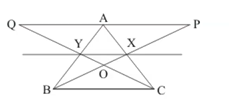In Figure, are the midpoints of the sides respectively of right angled at C. Prove that .
To prove that 4(AQ2+BP2)=5AB2 given that P and Q are the midpoints of sides CA and CB respectively in triangle ABC right-angled at C, we can follow these steps:
Step 1: Identify the triangles and apply the Pythagorean theorem
In triangle ACQ:
- Since Q is the midpoint of CB, we have CQ=12CB.
- By the Pythagorean theorem, we can write:
AQ2=AC2+CQ2
Substituting CQ=12CB:
AQ2=AC2+(12CB)2
AQ2=AC2+14CB2
Step 2: Rearranging the equation for AQ
Multiplying the entire equation by 4 gives:
4AQ2=4AC2+CB2
Step 3: Apply the Pythagorean theorem in triangle BPC
In triangle BPC:
- Since P is the midpoint of CA, we have CP=12CA.
- By the Pythagorean theorem, we can write:
BP2=BC2+CP2
Substituting CP=12CA:
BP2=BC2+(12CA)2
BP2=BC2+14CA2
Step 4: Rearranging the equation for BP
Multiplying the entire equation by 4 gives:
4BP2=4BC2+CA2
Step 5: Combine the equations for AQ and BP
Now, adding the two equations from steps 2 and 4:
4AQ2+4BP2=(4AC2+CB2)+(4BC2+CA2)
This simplifies to:
4AQ2+4BP2=4AC2+4BC2+CA2+CB2
Step 6: Use the Pythagorean theorem for triangle ABC
In triangle ABC:
AB2=AC2+BC2
Thus, we can express AC2+BC2 as AB2:
4AQ2+4BP2=4(AB2)+(CA2+CB2)
Step 7: Final rearrangement
Since CA2+CB2=AB2 (from the right triangle property), we can substitute:
4AQ2+4BP2=5AB2
Conclusion
Thus, we have proven that:
4(AQ2+BP2)=5AB2
In triangle ACQ:
- Since Q is the midpoint of CB, we have CQ=12CB.
- By the Pythagorean theorem, we can write:
AQ2=AC2+CQ2
Substituting CQ=12CB:
AQ2=AC2+(12CB)2
AQ2=AC2+14CB2
Multiplying the entire equation by 4 gives:
4AQ2=4AC2+CB2
In triangle BPC:
- Since P is the midpoint of CA, we have CP=12CA.
- By the Pythagorean theorem, we can write:
BP2=BC2+CP2
Substituting CP=12CA:
BP2=BC2+(12CA)2
BP2=BC2+14CA2
Multiplying the entire equation by 4 gives:
4BP2=4BC2+CA2
Now, adding the two equations from steps 2 and 4:
4AQ2+4BP2=(4AC2+CB2)+(4BC2+CA2)
This simplifies to:
4AQ2+4BP2=4AC2+4BC2+CA2+CB2
In triangle ABC:
AB2=AC2+BC2
Thus, we can express AC2+BC2 as AB2:
4AQ2+4BP2=4(AB2)+(CA2+CB2)
Since CA2+CB2=AB2 (from the right triangle property), we can substitute:
4AQ2+4BP2=5AB2
Thus, we have proven that:
4(AQ2+BP2)=5AB2
Topper's Solved these Questions
Similar Questions
In Figure, XandY are the mid-points of ACandAB respectively, QP,BCandCYQandBXP are straight lines. Prove that ar(ABP)=ar(ACQ)
 View Solution
View SolutionIn a ABC,EandF are the mid-points of ACandAB respectively. The altitude AP to BC intersects FE at Q Prove that AQ=QP
View Solutionp AND q are any two points lying on the sides DC and AD respectively of a parallelogram ABCD. Show that ar(APB)=ar (BQC).
View SolutionIn a triangle, P, Q and R are the mid-points of sides BC, CA and AB respectively. If AC=21 cm, BC=29cm and AB=30cm, find the perimeter of the quadrilateral ARPQ
View SolutionIn Figure, triangle ABC is right-angled at B. Give that AB=9CM, AC=15CM,andD,E are the mid-points of the sides ABandAC respectively, calculate
The length of BC
(ii) The area of ADEView SolutionProve that the figure formed by joining the mid-points of the pair of consecutive sides of a quadrilateral is a parallelogram. OR BACD is a parallelogram in which P,Q,R and S are mid-points of the sides AB,BC,CD and DA respectively. AC is a diagonal. Show that : PQ∣∣AC and PQ=12AC SR∣∣AC and SR=12AC PQ=SR (iv) PQRS is a parallelogram.
View SolutionIn triangle ABC,po∈tsD,EandF are taken on the sides BC,CAandAB, respectigvely, such that BDDC=CEEA=AFFB=n. Prove that _(DEF)=n2−n+1((n+1)2)ABC.
View SolutionIn a triangle ABC , let PandQ be points on ABandAC respectively such that PQ∣∣BC . Prove that the median AD bisects PQ.
View SolutionIn square ABCD, P and Q are mid-point of AB and CD respectively. If AB=8cm and PQ and BD intersect at O, then find area of OPB
View SolutionP and Q are points on sides AB and AC respectively of ABC . If AP=3cm , PB=6cm , AQ=5cm and QC=10cm , show that BC=3 PQ .
View Solution
